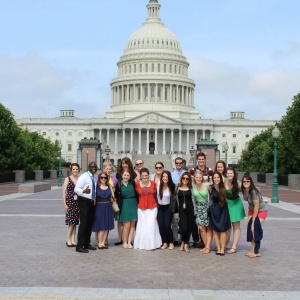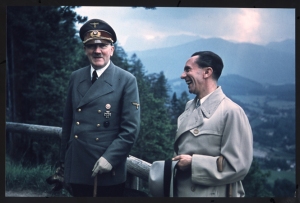This week, the University Programs Division is hosting a workshop about restitution and reparations. I somehow ended up being at the table with nine scholars from around the world. The greatest piece of news is that I have a name placard (one that I printed), which makes me feel very official! They are discussing many different aspects of restitution since 1945 in multiple countries. Each of them came with a specialty of their own, and their narratives have proven to be very different from each other.
On Friday, I became fascinated with conversations on modern-day antisemitism. I guess I have been naïve about post-war reconciliation. I assumed that after the war, once the world knew about the terrible crimes of the Holocaust, there would have had to be a complete reversal of antisemitism. From an American perspective, it’s difficult to imagine laws still being passed in Europe that can relatively easily be considered antisemitic. Someone casually mentioned a law in Poland that makes kosher slaughter illegal, which effectively makes it impossible for the Jewish community to remain kosher in Poland. The law that would have created an exception for religious reasons to this original law, was rejected only a few weeks ago. I was stunned when I read about this. Banning kosher slaughter was a step taken by Hitler only weeks into his Third Reich, and one that was taken by other European countries such as Norway and Sweden in the 1930’s. I guess I assumed that there would be additional sensitivity to antisemitism in Europe because of the history of the Holocaust. It looks like the constitutional challenge will be taken to the higher courts in Poland, so we shall see how it all works out. Obviously these laws have been argued for by animal rights proponents, but I know that if I was trying to be kosher in Poland I would certainly feel targeted by these laws. I find it difficult to interpret it any other way.
I have attended some really interesting events in the last few weeks. I feel incredibly lucky to be here, surrounded by opportunities to hear from brilliant people with inspirational ideas.
Last week, the Holocaust museum hosted a conference on the concept of “Responsibility to Protect (R2P)” in relation to Syria. I asked for the morning off to be able to see Madeleine Albright for the first time, as well as former ambassador to Sudan, Richard S. Williamson, David Ignatious from the Washington Post, former minister of foreign affairs of Canada, Llyod Axworthy, former ambassador Nicholas Burns, Michael Gerson also from the Washington Post, Heather Hulbert from the National Security Network, and Susan Glasser, the editor of Politico Magazine. This conference was fascinating. Albright explained R2P as a series of agreements that will guide the international community and individual leaders to make decisions regarding human rights. The so-called “pillars” are:
- Every state has the duty to protect its citizens from ethnic cleansing
- The international community has the duty to help states stop genocide
- In the absence of the first two, the international community has the duty to stop genocide (using a wide range of measures, with military intervention coming last)
As a result of the panelists’ real-life experience with the subject, the panels were all excellent. There were a number of former officials from the Bush administration, which was interesting for me. President Bush was the first American president to sign on to the concept of R2P, which meant his officials are some of the ones going out and promoting it. At the end of her presentation about the new R2P report, Madeleine Albright said, “See? This is what happens when Democrats and Republicans work together!” Albright and Williamson tended to talk about the big ideas of R2P, and mostly skirted around specifics in Syria. But Albright was emphatic that the U.S. has good enough intelligence now to know what is going on on the ground. She no longer accepts this as an excuse for inaction. Williamson made a great point about how ultimately solving a problem early on will always be cheaper than cleaning up afterwards (referring to the price of refugees, the disruption of the affected economies, humanitarian aid, etc.). This was in response to the news this week that enforcing a no-fly zone in Syria will cost the U.S. $1 billion a month. They discussed at-length the difficulties of inducing the war-weary U.S. to intervene in Syria. David Ignatious said, “war weariness doesn’t absolve a nation from the moral responsibility to act,” which wore me out struggling to decide how I felt about that.
Both the R2P conference and the workshop on restitution were dealing heavily with the concept of restorative justice and transitional justice. This is a whole new ballgame for me, but it has kept me wondering about how people are able to move on after crises and if they do at all. The reparations being discussed in the workshop seem… somehow frivolous. I think the simple recognition and apology from the government that comes along with the cash is probably more valuable to the victims themselves. This is obviously a gross simplification of the issue, but it’s the conclusion I have come to at the end of this week. Since I also happened to see the new Hannah Arendt movie this week, I am thinking about the court cases that attempted to bring justice to the victims of the Holocaust and the other attempts made after the Rwandan genocide and the Cambodian genocide. Does putting an individual on trial for such an enormous crime help the victims heal? I hope so. At the very least, I do agree that it is important to document and show to the world the crimes committed through these trials.
This week I also happened to see Senator Claire McCaskill drinking a beer at a Buzzfeed event and Senator Al Franken at his constituent breakfast. It’s pretty cool to be in a place where I can have such easy access to the leaders of our government. I had the chance to make Al Franken feel old (oops!) and laugh at Senator McCaskill’s twitter-savvy jokes. I came to the conclusion that I live in a pretty cool country! Today, my friend from CMC also took me out sailing for the first time. It was fun seeing her in her element out on the water. Aside from some seasickness, the weather was beautiful and I was really happy to get out of the city.




